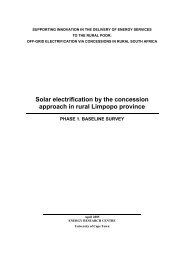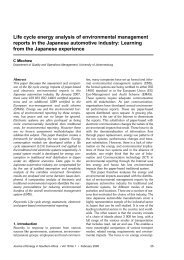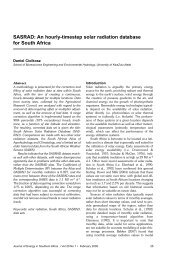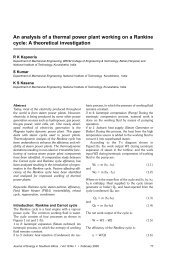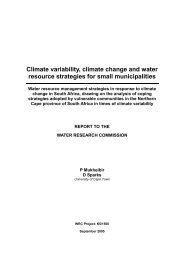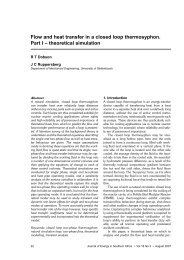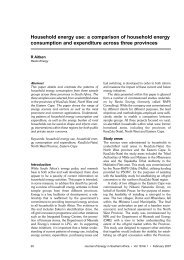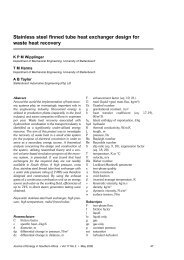Heat recovery in the textile dyeing and finishing industry ... - erc
Heat recovery in the textile dyeing and finishing industry ... - erc
Heat recovery in the textile dyeing and finishing industry ... - erc
Create successful ePaper yourself
Turn your PDF publications into a flip-book with our unique Google optimized e-Paper software.
technology is <strong>the</strong> <strong>in</strong>corporation of heat exchangers<br />
on such <strong>textile</strong> mach<strong>in</strong>es with <strong>the</strong> purpose of heat<strong>in</strong>g<br />
up <strong>the</strong> <strong>in</strong>com<strong>in</strong>g cold-water stream with hot<br />
wastewater leav<strong>in</strong>g <strong>the</strong> mach<strong>in</strong>e.<br />
Centralised waste water heat <strong>recovery</strong><br />
Batch or non-cont<strong>in</strong>uous process<strong>in</strong>g is common <strong>in</strong><br />
many plants. Thus, a large volume of wastewater is<br />
available <strong>in</strong>termittently from several mach<strong>in</strong>es at<br />
different locations <strong>in</strong> <strong>the</strong> plant. If wastewater can<br />
nei<strong>the</strong>r be re-used nor can its heat be recovered<br />
locally, <strong>the</strong> feasibility of <strong>in</strong>stall<strong>in</strong>g a centralised heat<br />
<strong>recovery</strong> system should be <strong>in</strong>vestigated.<br />
The system <strong>in</strong>volves stor<strong>in</strong>g hot wastewater <strong>in</strong> a<br />
large tank from where a hot stream is pumped to a<br />
heat exchanger <strong>in</strong> order to warm up process water.<br />
Experience has shown that <strong>the</strong> payback period is<br />
<strong>in</strong>variably more than 12 months <strong>and</strong> a payback of<br />
18 to 36 months is common (EEO, 1992a; Pozzi,<br />
1982; ITF, 1981). The importance of an <strong>in</strong>-depth<br />
feasibility study should not be underestimated –<br />
examples <strong>in</strong> <strong>the</strong> literature have shown that <strong>in</strong> some<br />
cases, <strong>the</strong> payback period can extend over more<br />
than 10 years <strong>in</strong> spite of <strong>the</strong> availability of a large<br />
volume of waste water at high temperature<br />
(Woodall et al., 1976). Figure 1 shows a typical setup<br />
for centralized waste water <strong>recovery</strong>.<br />
Condensate <strong>recovery</strong><br />
The fuel consumption <strong>in</strong> a dye<strong>in</strong>g <strong>and</strong> f<strong>in</strong>ish<strong>in</strong>g<br />
plant should decrease by about 1% for every 6°C<br />
rise <strong>in</strong> <strong>the</strong> boiler feed-water temperature (EEO,<br />
1984a). As it is pure <strong>and</strong> it has a high temperature,<br />
condensate should be returned to <strong>the</strong> boiler unless<br />
<strong>the</strong> user site is far from <strong>the</strong> boiler-house or contam<strong>in</strong>ation<br />
is a risk. However, a low efficiency <strong>in</strong> condensate<br />
<strong>recovery</strong> is common due to problems with<br />
<strong>the</strong> condensate network <strong>and</strong> with flash steam <strong>recovery</strong>.<br />
Figure 2 illustrates a typical condensate <strong>recovery</strong><br />
system.<br />
Waste-water heat exchangers<br />
Shell-<strong>and</strong>-tube <strong>and</strong> plate heat exchangers have<br />
been used with mixed results <strong>in</strong> heat <strong>recovery</strong> <strong>in</strong><br />
<strong>in</strong>dustry (F<strong>in</strong>be<strong>in</strong>er, 1987; Raym<strong>and</strong> 1984; APV,<br />
1996). The latter is generally preferred to <strong>the</strong> former<br />
because its heat transfer efficiency is higher by 3 to<br />
5 times. Plate heat exchangers require less capital<br />
<strong>in</strong>vestment than shell-<strong>and</strong>-tube heat exchangers<br />
made of materials like high-grade sta<strong>in</strong>less steel,<br />
essential to resist corrosion due to <strong>textile</strong> wastewater.<br />
However, both are affected by foul<strong>in</strong>g<br />
(F<strong>in</strong>be<strong>in</strong>er, 1987).<br />
Thus, designers <strong>in</strong> <strong>the</strong> 1980’s <strong>in</strong>troduced a new<br />
concept aimed at atta<strong>in</strong><strong>in</strong>g high heat <strong>recovery</strong> effi-<br />
Figure 1: Centralised waste water heat <strong>recovery</strong><br />
Figure 2: Pump <strong>and</strong> condensate receiver<br />
10 Journal of Energy <strong>in</strong> Sou<strong>the</strong>rn Africa • Vol 21 No 3 • August 2010




